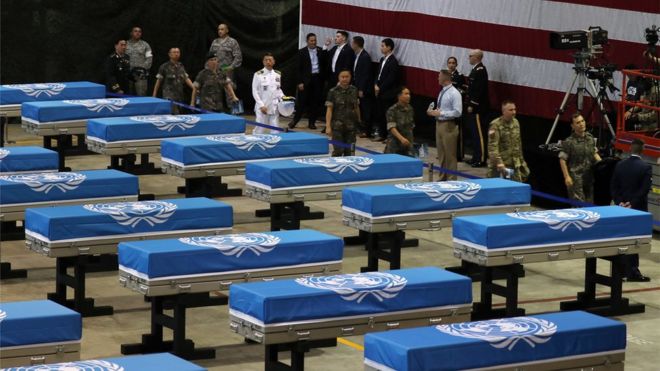The recent return of several hundred remains of US service personnel from North Korea is a commendable move for the Communist dictatorship. The return of these remains offers hope to families that have long wondered about the fate of their loved ones. The Korean War has often been referred to as the Forgotten War and many feel that the 8,000 plus servicemen that were designated as MIA have long been forgotten. The Korean War, or more properly Korean Conflict, was a police action carried out under the auspices of the United Nations. There was a lot of confusion among Americans about the purpose and objectives of this conflict. The military combined seasoned veterans with fresh recruits, many of them having been drafted, to face the small North Korean Army. Unfortunately, the North Koreans were augmented by both Chinese and Soviet forces. This was the closest the US came to a full out ground war against the major Communist powers. The conflict ended with an armistice, really just a pause in the fighting, and there was no permanent resolution of the conflict. The American public was even more confused about the end of the war and the missing soldiers and sailors were forgotten. The return of these remains is a positive step in honoring the men and women that sacrificed their all for their nation.
Of course, the several hundred remains are just a drop in the bucket compared with the over 8,000 missing servicemen. A large portion of the missing servicemen will never be reclaimed. This is not only true of the Korean War, but of every other American conflict. There have been MIAs in nearly every American conflict. There were hundreds of thousands of MIAs after the American Civil War. It was the Civil War that eventually led the US military to adopt standardized IDs, i.e. dog tags. Soldiers prior to battle in the American Civil War would pin strips of paper to their clothes with their name and address in case they were killed in battle. The average soldier came to fear being killed and forgotten on the massive fields of carnage. A much smaller number of MIAs were recorded in the Great War, but in the aftermath of that war the practice of recognizing an Unknown Soldier began. The Unknown Soldier, entombed in Washington DC, was the ultimate symbol of the soldier who was not only lost in battle, but the man who also lost his identity in the process. The Tomb of the Unknown Soldier came to represent all MIAs.
Today, the US military strives to identify the remains of all soldiers that are found in former conflict zones. They also work hard to eliminate once and for all the issue of MIAs. New techniques are employed to identify and track current soldiers. It is unlikely that the Tomb of the Unknowns will have a future addition due to these advances in technology. But that does not comfort those whose family members were lost in World War 2, Korea, or Vietnam. More than celebrate the return of remains from North Korea, the American public should take a moment to reflect on those who did sacrifice their lives in service. Memorials and museums dot the country, so it is not difficult to honor the men and women who were lost in defense of the US. Take time to go to places like the Andersonville Prison Museum that honors both POWs and MIAs throughout the history of the US. And let us also show our gratitude to current service personnel and their families as they still put their lives on the line for us all.
. 

